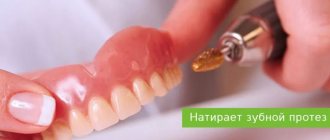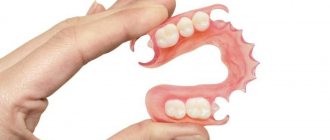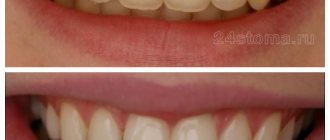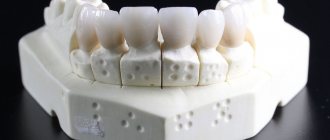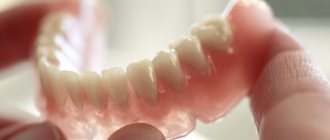A dental prosthesis is an artificial structure that restores part of a destroyed tooth, a completely missing tooth or a group of missing teeth and meets certain aesthetic and functional requirements.
Which prosthesis is best to place? There is no answer to this question. Because every patient may not be suitable for the same design. The choice of prosthesis depends on many factors in each clinical situation.
Currently, orthopedic dentistry can offer a very large number of prostheses, differing in types of design and types of materials from which these prostheses are made.
Main types of structures:
- Removable dentures - the patient can independently remove and put them on for hygiene purposes. These dentures are divided into partial dentures, complete dentures, partial dentures, and implant-supported dentures.
- Fixed dentures are permanently attached and are practically no different in care from natural teeth. Fixed ones include inlays, veneers, crowns and bridges on your teeth or implants
- Conditionally removable dentures are secured in such a way that they can be removed and then put on by a doctor while the patient is in a chair. These types of prostheses include bridges with locking fastenings, as well as all-on-4 prostheses
Warranty for dentures
A receipt is also provided for treatment, however, for a minimum period of time. If during this period a filling falls out due to the dentist’s fault, the doctor provides therapeutic services free of charge. Implants made of metal ceramics are guaranteed for 12 months. The guarantee for dental prosthetics according to the law of the Russian Federation provides for free elimination of deficiencies and re-performance of work.
- The materials used are of the same quality as previously used.
- Repair work is carried out or the device is replaced with a new one in the event that it breaks down due to defects in manufacturing.
- If the installation was carried out incorrectly, the design also changes.
During the specified period, if problems arise, the patient has the right to demand:
- Immediate elimination of defects free of charge;
- Reducing the cost of construction;
- Production of another device from the same type of material without payment;
In essence, these are the same obligations as for household appliances. In order to be able to carry out a replacement according to the law, you need to understand the nuances of this process. Care when signing documents is an important aspect of obtaining warranty services.
Stages of prosthetics
Creating a comfortable prosthesis with a minimal adaptation period will require several visits to the clinic. To eliminate inaccuracies in manufacturing, several pairs of impressions, fittings and bite testing are necessary.
- Taking impressions Taking preliminary impressions of the jaws to make a plaster model and final impressions to make a prosthesis template with the exact boundaries of the base.
- Bite study Determination and fixation of central occlusion based on facial characteristics using a facebow for transfer to the articulator in order to recreate the bite.
- Creating a template In the laboratory, the artificial teeth are first placed in the articulator on a wax template, taking into account the occlusion and the data obtained during the diagnosis.
- Try-ons The patient can visually evaluate the result and determine the degree of comfort. The doctor determines the relationship of the jaws in the oral cavity and their correspondence to facial features.
- Making a prosthesis When the template of the prosthesis is perfected, in the laboratory the model goes through a technological stage, the wax is replaced with a permanent plastic base through polymerization.
- Check in the articulator The bite is fixed with the finished prosthesis, the closure of the jaws is checked in the articulator in the clinic. If the smallest deviations are detected, adjustments are made.
The finished prosthesis is fixed to the jaw by applying slight pressure. Next comes the most important stage - getting used to or adapting to a removable denture. Sometimes there may be some discomfort in the first 1-2 weeks. It may be necessary to make a few more adjustments - we bring the prosthesis to an ideal state so that the person is extremely comfortable and convenient, so that he stops feeling it .
From the manufacturer
The manufacturer of artificial roots assumes responsibility if problems arise with the design.
- The warranty covers a period of 10 to 20 years.
- Sometimes they come with a lifetime warranty. This is the maximum period. It concerns cases where the screw is rejected due to the poor quality of the device.
If the titanium root had to be removed, after restoration of the bone tissue, a new pin is provided, and it is free for the patient. The warranty on removable dentures protects the patient from counterfeiting and defects. If a problem occurs, a new product is provided at the expense of the manufacturer. If the manufacturer's fault is proven, the client is supplied with a new system and its installation. The company will pay for all this. When a defect causes harm to health, the manufacturer pays for treatment.
Features of fixation on the upper and lower jaw
Removable dentures are held in the mouth due to the creation of a vacuum between the gum and the base (suction effect) and the anatomical features of the jaws
- On the upper jaw Fixation is carried out by blocking the palate. Increasing the contact area allows you to securely secure the artificial dentition, but leads to a decrease in comfort while wearing.
- to the lower jaw only due to the suction effect to the gums; in this case, it will not be possible to increase the contact area due to anatomical features. Therefore, the quality of fixation from below is always worse.
When using removable prosthetics, it is extremely important that the design exactly replicates the anatomy of the prosthetic bed . Otherwise, it will not be possible to achieve its stability, and under load the teeth will fly off. This is not the only problem with complete dentures; it is also worth noting:
- bulkiness, overlap of the palate with prosthetics of the upper jaw
- need for careful hygienic care
- discomfort, rubbing of the mucous membrane in the first 1-2 weeks of wearing
- resorption of bone tissue under the prosthesis.
Despite the shortcomings, if you approach the problem correctly, any negative aspects can be minimized.
Chashchin Kirill Valerievich
Orthopedic dentist
14 years of experience
Virtuoso of prosthetics. Competent planning and diagnostics, creation of comfortable removable dentures taking into account individual parameters.
More about the doctor
From the dental clinic
The dentist's office, when providing medical services, assumes certain obligations. They take a year or two to complete. All obligations of the clinic are included in the contract, which is signed before the procedure. The patient must follow all hygiene rules and the dentist's instructions. The clinic's obligations are governed by the provisions of the contract concluded with the client. This document specifies the rights and responsibilities of the medical institution and the patient, regardless of whether it is a removable implant or fixed dental prosthetics.
The standard documents indicate:
- Carrying out the operation using new technology and high-quality materials. The orthopedist will have the necessary skills and abilities.
- The use of certain implantation devices from well-known manufacturers. If the clinic does not adhere to this, the quality of the device can be forgotten.
- Equipping the clinic with modern equipment. The instruments must meet all medical standards.
- Anesthesia that relieves the patient of pain and does not cause harm to health.
An important point is the establishment of regulations for the use of disposable instruments, as well as the sterilization of premises and devices.
Making crowns from plastic
Crowns made by dental technicians are of high quality, although the manufacturing process does not require complex equipment and does not take much time. However, in order for the crowns to match the orthodontic characteristics of the patient's dentition, impressions must be made. The mold created from the impression is filled with polymer, which takes several minutes to harden. After removal from the mold, the crown is polished and fixed to the tooth using special cement.
There are also highly elastic silicone reusable molds for restoring the crown of a tooth from a polymer mass. Such silicone molds can be ordered for a specific patient and will be made according to his impressions for both one tooth and a number of neighboring teeth. Thus, in dental clinics it is proposed to replace defects in the dentition with solid plastic crowns. Standard silicone molds are also available in various sizes and types: incisors, premolars and molars.
How long does a denture last?
The service life of orthodontic structures is affected by the material. With good care and no damage or displacement due to impacts and injuries, the systems do not need adjustment. How long do they serve?
- Metal and ceramic structures - 10-12 years;
- Ceramic devices made of solid material – 5-7 years;
- Devices made of plastic and metal – 3-5 years;
- The service life of dentures made of plastic is short. After 12 months, their appearance changes. Patients may experience an allergic reaction. Therefore, such structures are used as temporary ones. They are inexpensive.
Removable systems are replaced every 15 years. Zirconium structures last twenty years or more. The service life and reliability of the structure depend on the physical properties and mechanical strength of the material. The microstructure of the system and the reliability of its connecting nodes are of great importance. It is impossible not to take into account the condition of the patient’s bone tissue and the professionalism of the dentist. Implants will last longer if they are well cared for.
What experts recommend
To avoid complications and install a high-quality, durable prosthesis, you need to contact an experienced orthopedist who will conduct a full examination before prosthetics and model an anatomically correct design. It is also important that the support is properly prepared - the canals are thoroughly cleaned and sealed, the upper part is sharpened, and a suitable implant is selected. To restore teeth, today they offer several methods for making crowns, and the optimal one is milling using CAD/CAM technology. This results in very tight-fitting structures, under which germs and food particles do not penetrate, so they last longer than others.
How to extend the life of dentures
Repair of dentures in St. Petersburg is a service that is provided by many clinics. If necessary, the patient should consult an orthodontist. If a breakdown occurs, it is strictly prohibited to carry out repair work yourself. This is fraught with serious complications.
In order for the system to live longer and function well, it is enough to carry out simple measures:
- Carrying out daily hygiene procedures twice a day. Artificial units must be thoroughly cleaned of food debris and plaque. They should be rinsed after eating. Removable appliances are removed from the mouth. They are soaked in antiseptic liquids.
- Protection from strong impacts and jaw injuries, so as not to damage the structure.
- Normalization of nutrition and lifestyle, exclusion of solid foods from the diet, inclusion of vitamins in the menu.
- Regular dental checkups. The doctor will promptly detect a chip or crack in the structure. This will prevent inflammation of the pulp or soft tissue.
Complications in case of untimely replacement
If you visit the dentist irregularly or endure pain for a long time, then dangerous complications are likely to occur, such as gum loss, local periodontitis, marginal periodontitis, tooth decay, the appearance of cysts and granulomas at the roots, peri-implantitis - inflammation around the implant. All these conditions are fraught with removal of the root/implant and prolonged recovery (if the bone was severely infected).
PROSTHETICS WITH 6 OSSTEM IMPLANTS FROM RUB 200,000.
Complex implantation Osstem (South Korea) with delayed loading after 4-6 months.
Call now or request a call
“I somehow missed the moment that the crown began to wobble, so I didn’t go to the dentist. But a few days later, during lunch, I felt that it had fallen off altogether. Almost swallowed it! I thought it would be possible to glue it in place. But the prosthetist said it was too late, the root was cracked and needed to be removed. Here. So now I’ll have to make a bridge or an implant. Not decided yet". Sergey, review from the website stomatology.rf
Your questions and answers
QUESTION Is it possible to exchange a crown (more precisely, a bridge) for an implant and two crowns on the sides? The old bridge is shaky, and for some reason I didn’t like it. The front teeth don't look very good. Dmitriy
ANSWER Dmitry, without the results of an x-ray examination it is quite difficult to answer your question in the affirmative, because It is unknown what condition the supporting teeth are in. If it’s good, then the option you proposed is quite possible. But here, most likely, the crowns on the “former” supports and on the implant itself will be placed at different times, since it will be necessary to wait for the implant to heal. But it is possible that while healing is ongoing, the dentist will place a temporary bridge on all three teeth. If now the supports are in unsatisfactory condition and they need to be removed, then they can put 3 implants - and a crown for each, or combine the implants with a bridge.
1Haug S. Correct modeling, 2006.
Author: Dulgarov Zh. G. (Thank you for your help in writing the article and the information provided)
